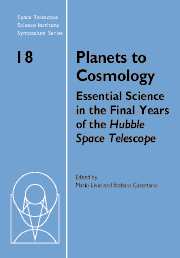 Planets to Cosmology
Planets to Cosmology Book contents
- Frontmatter
- Contents
- Participants
- Preface
- Hubble's view of transiting planets
- Unsolved problems in star formation
- Star formation in clusters
- HST abundance studies of low metallicity stars
- Physical conditions and feedback: HST studies of intense star-forming environments
- Quasar hosts: Growing up with monstrous middles
- Reverberation mapping of active galactic nuclei
- Feedback at high redshift
- The baryon content of the local intergalactic medium
- Hot baryons in supercluster filaments
- Galaxy assembly
- Probing the reionization history of the Universe
- Studying distant infrared-luminous galaxies with Spitzer and Hubble
- Galaxies at z ≈ 6–i′-drop selection and the GLARE Project
- The Hubble Ultra Deep Field with NICMOS
Physical conditions and feedback: HST studies of intense star-forming environments
Published online by Cambridge University Press: 17 August 2009
- Frontmatter
- Contents
- Participants
- Preface
- Hubble's view of transiting planets
- Unsolved problems in star formation
- Star formation in clusters
- HST abundance studies of low metallicity stars
- Physical conditions and feedback: HST studies of intense star-forming environments
- Quasar hosts: Growing up with monstrous middles
- Reverberation mapping of active galactic nuclei
- Feedback at high redshift
- The baryon content of the local intergalactic medium
- Hot baryons in supercluster filaments
- Galaxy assembly
- Probing the reionization history of the Universe
- Studying distant infrared-luminous galaxies with Spitzer and Hubble
- Galaxies at z ≈ 6–i′-drop selection and the GLARE Project
- The Hubble Ultra Deep Field with NICMOS
Summary
Starbursts represent a different style of star-forming activity: not only is star formation more intense, but it also tends to produce more stars in compact, massive star clusters. This concentration of stars into small regions and their influence on the surroundings sets a requirement for high angular resolution observations over a range of wavelengths that only HST can meet. These points are illustrated through a discussion of some of the current issues regarding the nature and impact of super star clusters in nearby starburst galaxies.
Introduction
Starbursts are not simply scaled-up versions of the disks of normal spiral and irregular galaxies. The composite HST WFPC2 image of the classic starburst galaxy M82 in Figure 1 illustrates some of the differences. Star formation is localized in a well-defined central zone, where it is concentrated in clumps, beyond which there is virtually no star-forming activity (O'Connell & Mangano 1978). The well-known superwind extends above and below the plane out to kiloparsecs beyond the main starburst zone (Shopbell & Bland-Hawthorn 1998 and references therein). In M82 we can observe the combined effects of stellar feedback and a weak interaction with M81 in sufficient detail to test our models of galactic star formation. This is critical for understanding how the cycling of baryonic matter through stars relates to the overall structure of a galaxy, including its dark matter halo; e.g., through its influence in varying the luminosity part of the Tully–Fisher relationship (van Driel, van den Broek & Baan 1995).
- Type
- Chapter
- Information
- Planets to CosmologyEssential Science in the Final Years of the Hubble Space Telescope: Proceedings of the Space Telescope Science Institute Symposium, Held in Baltimore, Maryland May 3–6, 2004, pp. 63 - 72Publisher: Cambridge University PressPrint publication year: 2006


